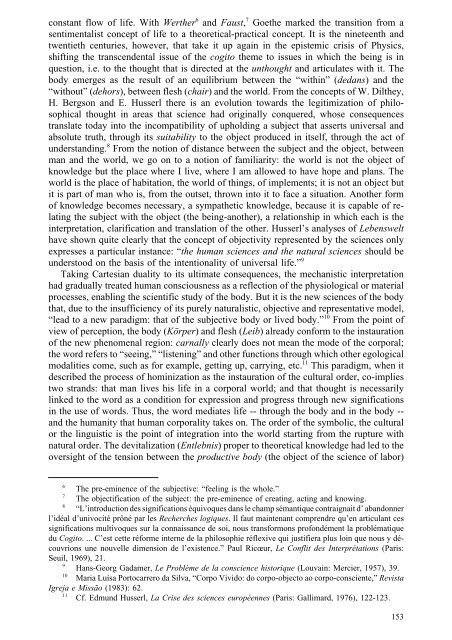[Andrzej_Wiercinski_(ed ... - WordPress.com
[Andrzej_Wiercinski_(ed ... - WordPress.com
[Andrzej_Wiercinski_(ed ... - WordPress.com
Create successful ePaper yourself
Turn your PDF publications into a flip-book with our unique Google optimized e-Paper software.
constant flow of life. With Werther 6 and Faust, 7 Goethe mark<strong>ed</strong> the transition from asentimentalist concept of life to a theoretical-practical concept. It is the nineteenth andtwentieth centuries, however, that take it up again in the epistemic crisis of Physics,shifting the transcendental issue of the cogito theme to issues in which the being is inquestion, i.e. to the thought that is direct<strong>ed</strong> at the unthought and articulates with it. Thebody emerges as the result of an equilibrium between the “within” (d<strong>ed</strong>ans) and the“without” (dehors), between flesh (chair) and the world. From the concepts of W. Dilthey,H. Bergson and E. Husserl there is an evolution towards the legitimization of philosophicalthought in areas that science had originally conquer<strong>ed</strong>, whose consequencestranslate today into the in<strong>com</strong>patibility of upholding a subject that asserts universal andabsolute truth, through its suitability to the object produc<strong>ed</strong> in itself, through the act ofunderstanding. 8 From the notion of distance between the subject and the object, betweenman and the world, we go on to a notion of familiarity: the world is not the object ofknowl<strong>ed</strong>ge but the place where I live, where I am allow<strong>ed</strong> to have hope and plans. Theworld is the place of habitation, the world of things, of implements; it is not an object butit is part of man who is, from the outset, thrown into it to face a situation. Another formof knowl<strong>ed</strong>ge be<strong>com</strong>es necessary, a sympathetic knowl<strong>ed</strong>ge, because it is capable of relatingthe subject with the object (the being-another), a relationship in which each is theinterpretation, clarification and translation of the other. Husserl’s analyses of Lebenswelthave shown quite clearly that the concept of objectivity represent<strong>ed</strong> by the sciences onlyexpresses a particular instance: “the human sciences and the natural sciences should beunderstood on the basis of the intentionality of universal life.” 9Taking Cartesian duality to its ultimate consequences, the mechanistic interpretationhad gradually treat<strong>ed</strong> human consciousness as a reflection of the physiological or materialprocesses, enabling the scientific study of the body. But it is the new sciences of the bodythat, due to the insufficiency of its purely naturalistic, objective and representative model,“lead to a new paradigm: that of the subjective body or liv<strong>ed</strong> body.” 10 From the point ofview of perception, the body (Körper) and flesh (Leib) already conform to the instaurationof the new phenomenal region: carnally clearly does not mean the mode of the corporal;the word refers to “seeing,” “listening” and other functions through which other egologicalmodalities <strong>com</strong>e, such as for example, getting up, carrying, etc. 11 This paradigm, when itdescrib<strong>ed</strong> the process of hominization as the instauration of the cultural order, co-impliestwo strands: that man lives his life in a corporal world; and that thought is necessarilylink<strong>ed</strong> to the word as a condition for expression and progress through new significationsin the use of words. Thus, the word m<strong>ed</strong>iates life -- through the body and in the body --and the humanity that human corporality takes on. The order of the symbolic, the culturalor the linguistic is the point of integration into the world starting from the rupture withnatural order. The devitalization (Entlebnis) proper to theoretical knowl<strong>ed</strong>ge had l<strong>ed</strong> to theoversight of the tension between the productive body (the object of the science of labor)6The pre-eminence of the subjective: “feeling is the whole.”7The objectification of the subject: the pre-eminence of creating, acting and knowing.8“L’introduction des significations équivoques dans le champ sémantique contraignait d’ abandonnerl’idéal d’univocité prôné par les Recherches logiques. Il faut maintenant <strong>com</strong>prendre qu’en articulant cessignifications multivoques sur la connaissance de soi, nous transformons profondément la problématiqu<strong>ed</strong>u Cogito. ... C’est cette réforme interne de la philosophie réflexive qui justifiera plus loin que nous y découvrionsune nouvelle dimension de l’existence.” Paul Ricœur, Le Conflit des Interprétations (Paris:Seuil, 1969), 21.9Hans-Georg Gadamer, Le Problème de la conscience historique (Louvain: Mercier, 1957), 39.10Maria Luísa Portocarrero da Silva, “Corpo Vivido: do corpo-objecto ao corpo-consciente,” RevistaIgreja e Missão (1983): 62.11Cf. Edmund Husserl, La Crise des sciences européennes (Paris: Gallimard, 1976), 122-123.153


